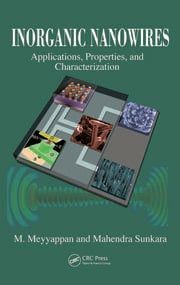1st Edition
Inorganic Nanowires Applications, Properties, and Characterization
Advances in nanofabrication, characterization tools, and the drive to commercialize nanotechnology products have contributed to the significant increase in research on inorganic nanowires (INWs). Yet few if any books provide the necessary comprehensive and coherent account of this important evolution.
Presenting essential information on both popular and emerging varieties, Inorganic Nanowires: Applications, Properties, and Characterization addresses the growth, characterization, and properties of nanowires. Author Meyyappan is the director and senior scientist at Ames Center for Nanotechnology and a renowned leader in nanoscience and technology, and Sunkara is also a major contributor to nanowire literature. Their cutting-edge work is the basis for much of the current understanding in the area of nanowires, and this book offers an in-depth overview of various types of nanowires, including semiconducting, metallic, and oxide varieties. It also includes extensive coverage of applications that use INWs and those with great potential in electronics, optoelectronics, field emission, thermoelectric devices, and sensors.
This invaluable reference:
- Traces the evolution of nanotechnology and classifies nanomaterials
- Describes nanowires and their potential applications to illustrate connectivity and continuity
- Discusses growth techniques, at both laboratory and commercial scales
- Evaluates the most important aspects of classical thermodynamics associated with the nucleation and growth of nanowires
- Details the development of silicon, germanium, gallium arsenide, and other materials in the form of nanowires used in electronics applications
- Explores the physical, electronic and other properties of nanowires
The explosion of nanotechnology research activities for various applications is due in large part to the advances in the growth of nanowires. Continued development of novel nanostructured materials is essential to the success of so many economic sectors, ranging from computing and communications to transportation and medicine. This volume discusses how and why nanowires are ideal candidates to replace bulk and thin film materials. It covers the principles behind device operation and then adds a detailed assessment of nanowire fabrication, performance results, and future prospects and challenges, making this book a valuable resource for scientists and engineers in just about any field.
Co-author Meyya Meyyappan will receive the Pioneer Award in Nanotechnology from the IEEE Nanotechnology Council at the IEEE Nano Conference in Portland, Oregon in August, 2011Introduction
Historical Perspective
Growth Techniques
Liquid-Phase Techniques
Vapor-Phase Techniques
Bulk Production Methods
Future Developments
Thermodynamic and Kinetic Aspects of Nanowire Growth
Thermodynamic Considerations for Vapor-Liquid-Solid Growth
Kinetic Considerations of Nanowire Growth Under VLS Growth
Modeling of Nanowire Growth
Energetics of Stable Surface Faceting: Silicon Nanowire Example
Simulation of Individual Nanowire Growth
Modeling of Multiple Nucleation and Growth of One-Dimensional Structures
Modeling Nanowire Array Growth
Semiconducting Nanowires
Silicon Nanowires
Germanium Nanowires
Catalyst Choice
III-V Nanowires
Phase Change Materials
Phase Change Nanowire Growth
Properties Relevant to PRAM
Metallic Nanowires
Bismuth Nanowires
Silver Nanowires
Copper Nanowires
Nickel Nanowires
Zinc Nanowires
Oxide Nanowires
Synthesis Methodologies
Directed Growth and Morphological Control
Oxygen Vacancies, Doping and Phase Transformation
Nitride Nanowires
Synthesis of Group III-Nitride Nanowires
Branching of Nanowires
Diameter Reduction of III-Nitride Nanowires
Direction Dependent Properties
Other Nanowires
Antimonides
Selenides
Tellurides
Sulfides
Silicides
Applications in Electronics
Silicon Nanowire Transistors
Vertical Transistors
Germanium Nanowire Transistors
Zinc Oxide and Other Nanowires in Electronics
III-V Transistors
Memory Devices
Applications in Optoelectronics
Photodetectors
Light Emitting Diodes
Nanoscale Lasers
Applications in Sensors
Chemical Sensors
Biosensors
Applications in the Renewable Energy Sector
Solar Cells
Electrochromic Devices
Li Ion Batteries
Other Applications
Field Emission Devices
Thermoelectric Devices
Biography
M. Meyyappan, Mahendra K. Sunkara



